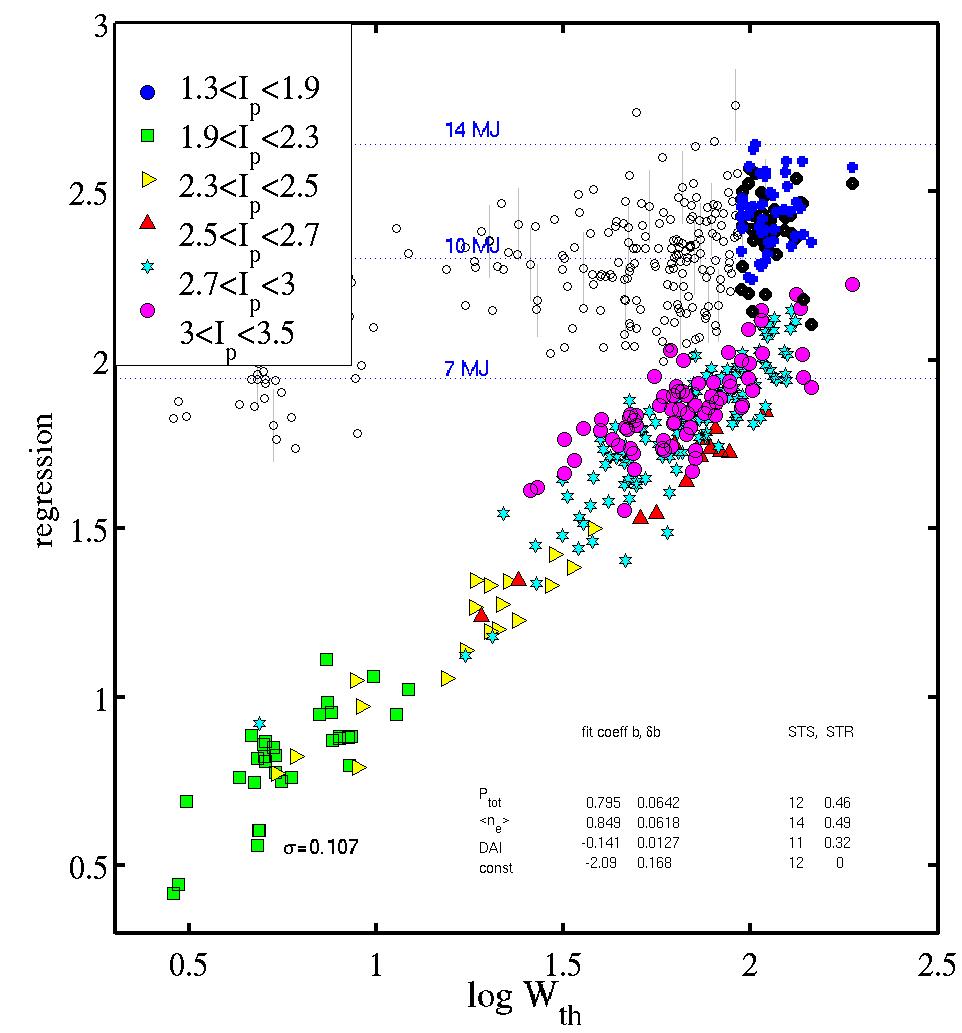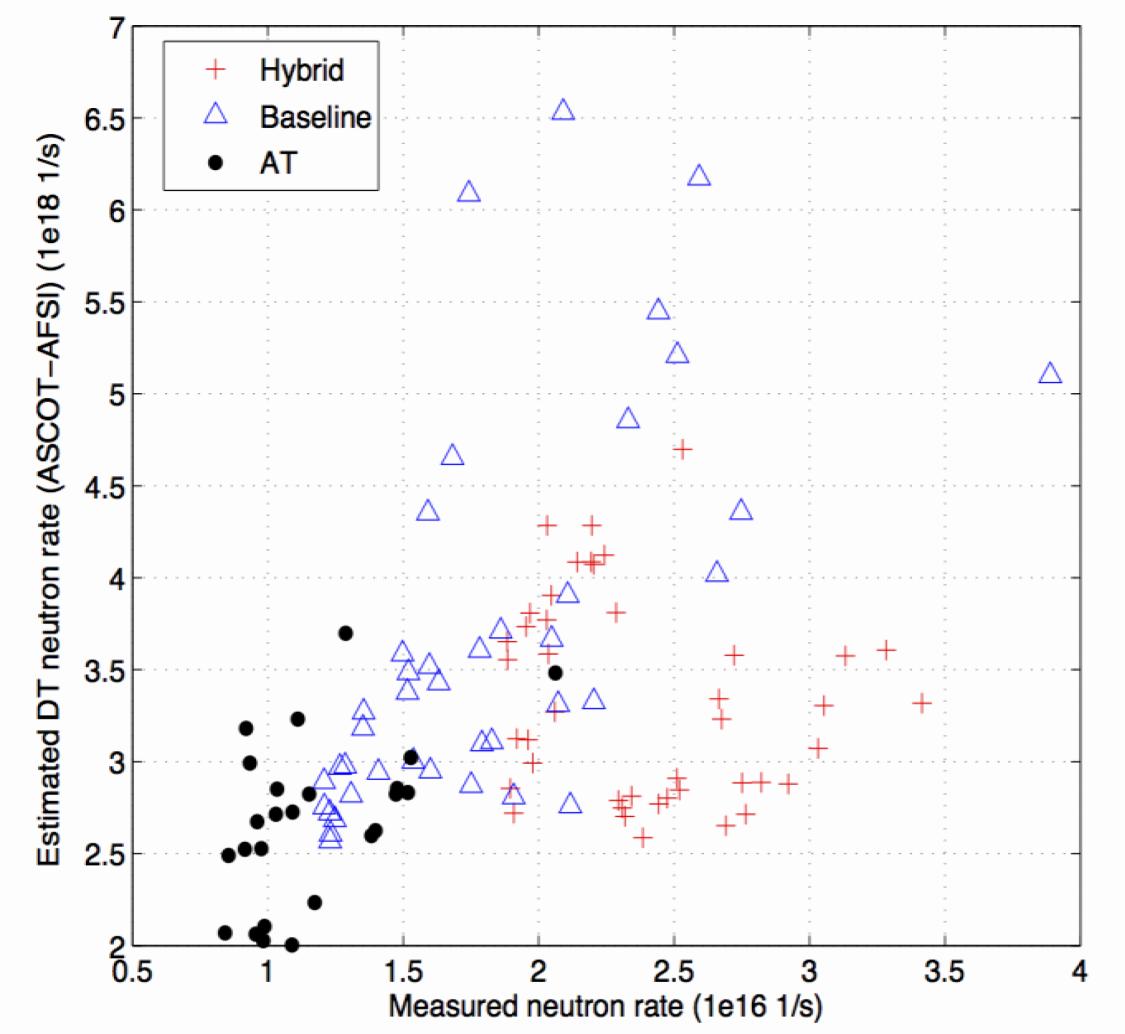Speaker
Description
Introduction
Flexible and easy-to-use extrapolation tools are needed for extrapolating to, and planning for, the forthcoming JET DT campaign (DTE2) $[$1$]$. For this purpose and based on the needs of the scientific teams involved in scenario development, a streamlined, automated analysis workflow for the ASCOT heating and fast particle following code [2,3] has been developed. The input to ASCOT can include any combination of experimental data or modelled data, such as profiles, and are taken from the JETPEAK database [4,5]. As it does not resort to physics based transport modelling, this procedure is much faster and capable of handling much larger datasets than is possible with integrated modelling approches. This allows intershot analysis within ~10 minutes and DT extrapolation over larger datasets (~10$^2$ samples), presented in this paper, to be completed overnight.
Scaling D plasmas to DT target conditions
ASCOT has been coupled with the JETPEAK [4,5] database and analysis environment. This database currently includes some 8000 samples from stationary phases in all JET-ILW experiments and more than 1000 structured variables from diagnostics and a variety of modelling codes. From this database, subsets in baseline (q$_{95}$$\approx$3, 𝐼$_p$$\le$3.5 MA), hybrid (q$_{95}$$\approx$4-4.5, 𝐼$_p$$\le$2.7 MA) and AT (q$_{95}$$\approx$4, 𝐼$_p$$\le$2.8 MA) discharges have been selected for extrapolation to DT conditions at target power (40 MW for baseline and hybrid, 30 MW for AT) and target current (4 MA for baseline, ~2.5 MA for hybrid, ~2.8 MA for AT). The expected stored energy, ion temperature profiles, electron temperature and density profiles are empirically extrapolated on the basis of power law regressions of the large available datasets in D plasmas. An example is shown in fig.1. The regression is shown with coloured symbols for different classes of plasma current in MA. The black circles correspond to direct extrapolations from the regression results. For the best performing cases an alternative extrapolation is also shown with blue + signs. For these it was assumed that an increase to target parameters scales with the power laws from the regression as W$_{th}$=W$_{th0}$$\Pi$(X$_i$/X$_{i0}$)$^{\alpha i}$, where the X$_i$ are the regression variables, $\alpha_i$ is the exponent for variable $i$ and subscript 0 stands for the case to be extrapolated.The best performing discharges extrapolated to thermal stored energies are in the range of 12-14 MJ, whichever regression method is used. These plasma profiles and the NBI parameters for D and T are then used as inputs for ASCOT, together with similarly extrapolated plasma densities and temperature ratios (T$_i$/T$_e$). For ASCOT based extrapolations, a confinement enhancement consistent with the observed isotope scaling in hydrogen and deuterium plasmas, $\tau_E \propto$A$_{eff}^{0.4}$ where A$_{eff}$=$\sum$ A$_i$n$_i$/$\sum$ A$_i$n$_i$ is assumed [6].

DT extrapolation coupling ASCOT and JETPEAK
ASCOT has been used at JET for analysis actively since late 1990’s and during campaigns in 2016 (C36-37) it was extended with a complete fusion product module AFSI [7] and coupled with synthetic neutron diagnostics. The most comprehensive testing and validation against neutron production data was published in [4]. 𝐼$_p$$\le$2.5 Testing has been performed with the help of the Matlab interface for JETPEAK-ASCOT, in which ASCOT has been coupled to the JETPEAK database [4].
The latest step of development is a database-coupled interface and definition of new scalings for DT extrapolations are presented in this paper. The analysis has been carried out for sets of baseline, hybrid and AT plasma samples, with the highest DD neutron rates achieved so far. The target NBI powers for these simulations were 34 MW for baseline and hybrid and 30 MW for AT. For DT extrapolations, the input profiles of the samples are scaled consistently with the scalings for W$_{th}$, n$_e$ and T$_i$/T$_e$ in deuterium as described above, specifically for each scenario. The set-up of the NBI system was appropriately adjusted to correspond to D and T beams and the target plasma was assumed to be 50% D, 50% T.
Fig.2 shows the calculated DT neutron rates against the measured neutron rates in D plasmas. A DT neutron rate of 5.3$\times$10$^{18}$ n/s corresponds to 15 MW of DT fusion power. The initial results suggest that both the baseline and the hybrid scenarios may reach DT fusion powers near 15 MW, which is one of the objectives of the upcoming DT campaign. These results are consistent with, and complementary to, recent results from integrated modelling [8].

Ongoing work includes expanding the analysis with wider data sets and systematic comparison of the results with other extrapolation tools, such as TRANSP, as well as predictions for alpha particle effects.
References
$[$1$]$ E. Joffrin et al., Nuclear Fusion 2019 https://doi.org/10.1088/1741-4326/ab2276
$[$2$]$ J. A. Heikkinen et al. 2001 J. Comput. Phys. 173 527-48
[3] E. Hirvijoki et al. 2014 Comput. Phys. Commun. 185 1310-1321
[4] P. Sirén et al. 2019 JINST 14 C11013
[5] H. Weisen et al, 2020 Nucl.Fusion 60 036004
[6] C. F. Maggi et al. 2019Plasma Phys. Control. Fusion 60 014045
[7] P. Sirén et al. 2018 Nucl. Fusion 58 016023
[8] J. Garcia et al. 2019 Nucl. Fusion 59 086047
This work has been carried out within the framework of the EUROfusion Consortium and has received funding from the Euratom research and training programme 2014-2018 and 2019-2020 under grant agreement No 633053. The views and opinions expressed herein do not necessarily reflect those of the European Commission.
| Affiliation | Aalto University |
|---|---|
| Country or International Organization | Finland |
